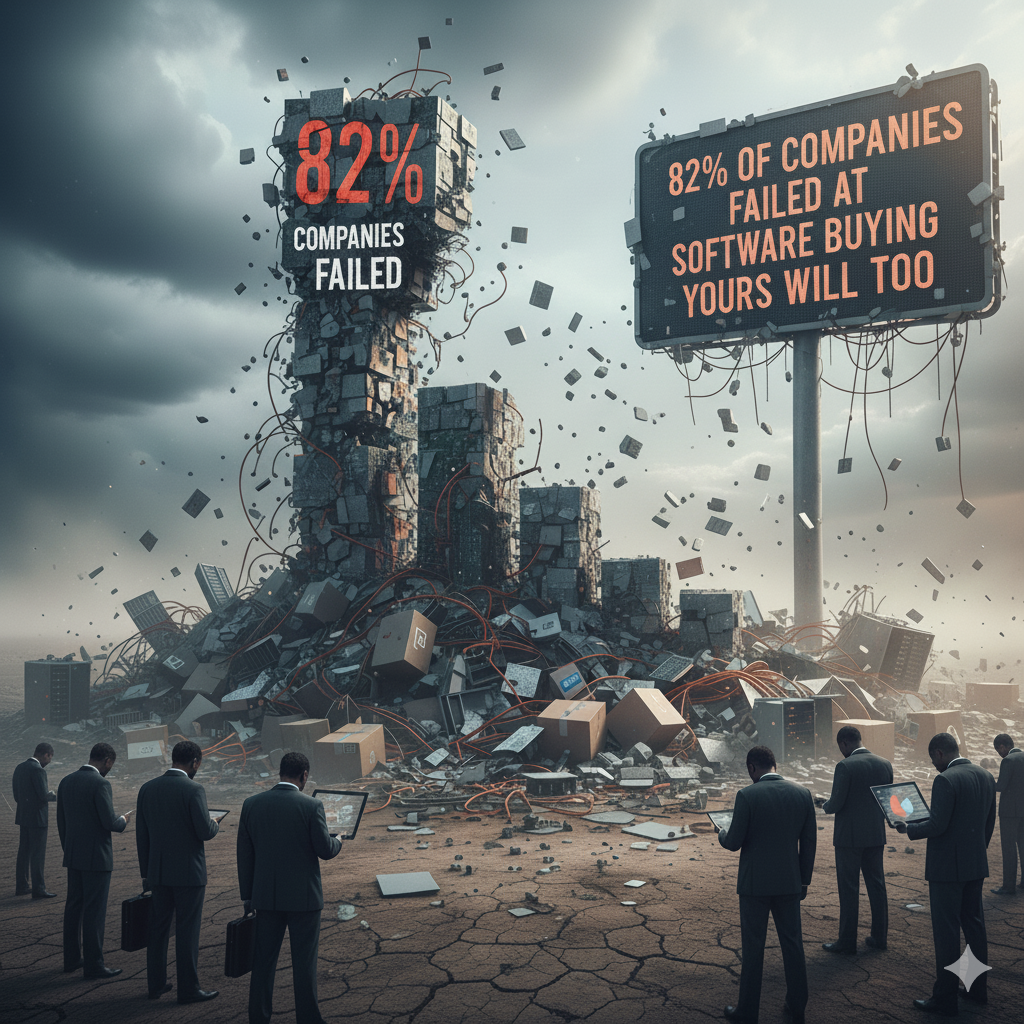82% of Companies Failed at Buying Software. Yours Will Too.
82% of companies missed their cost-reduction targets in 2024—the highest failure rate Deloitte has ever recorded in their annual MarginPlus Study. In an era of economic uncertainty and tighter budgets, this statistic isn't just alarming—it's a wake-up call for every organization investing in enterprise software.
But the problem runs deeper than missed targets. 70% of technology projects end in partial or total failure, according to research from the University of Oxford and McKinsey. When you're spending an average of $4,830 per employee on software annually, with 53% of licenses going completely unused, the cost of ineffective procurement becomes existential.
This isn't about bad luck or difficult vendors. It's about a fundamentally broken process that's overdue for disruption. Here's why traditional software procurement fails—and how AI is finally fixing it.
The Numbers Don't Lie: The Real Cost of Procurement Failure
The 82% Problem: Cost-Reduction Targets Nobody Hits
Deloitte's 2024 MarginPlus Study revealed that 82% of organizations failed to meet their cost-reduction objectives—a record high that reflects growing complexity in procurement operations. But this headline figure only scratches the surface of procurement's systemic failures.
McKinsey's research paints an even grimmer picture: Organizations lose 33% of their procurement pipeline's estimated value during planning stages alone, with another 20% vanishing during execution. Late additions recover a mere 15% of projected value, leaving companies billions of dollars short of their savings targets.
The Time Sink: 134 Days to Make a Decision
The average B2B SaaS buying cycle has ballooned to 134 days—up from 107 days just two years ago, according to Gartner's 2024 Software Buying Trends Report. For enterprise deals, this timeline stretches to 6-12 months, with some mission-critical implementations taking years.
This isn't just inconvenient—it's expensive. Every day of delay represents opportunity cost, competitive disadvantage, and mounting internal frustration. With 6-10 decision-makers involved in the average software purchase, coordination alone becomes a full-time job.
The Execution Gap: Where Savings Go to Die
Even when companies make it through the selection process, execution often fails. Gartner estimates that 70% of ERP implementations will fail to meet their objectives over the next three years. More specifically:
- 76% of implementations run 30% longer than planned
- 64% exceed their budgets, with overruns averaging 189-215% for failed projects
- Only 16.2% of projects finish on time and within budget
The financial waste is staggering. Organizations waste between $18-21 million annually on unused software licenses alone. Add implementation failures, and the numbers become catastrophic.
The Complexity Trap: Too Many Cooks in the Kitchen
The modern software buying process involves more stakeholders than ever before. With 6-10 decision-makers per deal—spanning IT, finance, operations, legal, and end users—achieving consensus becomes nearly impossible.
This complexity manifests in telling ways:
- 83% of buyers change their initial vendor list after doing research (Gartner)
- 58% of procurement leaders plan to implement AI within 12 months, signaling desperation for better tools
- 75% of business executives now anticipate their software projects will fail before they even begin
Why Traditional Procurement Processes Fail
Problem #1: Manual, Time-Consuming RFQ Creation
Creating a comprehensive Request for Quotation (RFQ) from scratch takes weeks of work. Procurement teams must:
- Research technical requirements across departments
- Translate business needs into technical specifications
- Create standardized evaluation criteria
- Develop comparison frameworks
- Coordinate stakeholder input
The result? Most companies either rush the RFQ process (leading to incomplete requirements and bad vendor matches) or delay projects for months while perfecting documentation nobody will read.
Problem #2: No Standard for Vendor Comparison
Without proper tools, comparing vendors becomes "spreadsheet hell." Different stakeholders maintain different criteria, pricing arrives in incompatible formats, and nobody can agree on how to weight various factors.
This leads directly to that 83% vendor list revision rate—organizations realize too late that they were comparing the wrong things or missing critical vendors entirely.
Problem #3: Poor Requirements Gathering
McKinsey's research identified inadequate requirements gathering as the #2 reason procurement transformations fail. The problem isn't lack of effort—it's lack of structure.
Traditional methods rely on:
- Endless stakeholder meetings that never reach consensus
- Email chains that lose critical details
- Documentation that's outdated the moment it's written
- Technical requirements that don't map to business outcomes
By the time requirements are "finalized," they've already diverged from what the business actually needs.
Problem #4: Analysis Paralysis
With 6-10 decision-makers and no clear framework for evaluation, procurement processes devolve into analysis paralysis. Every stakeholder has veto power, nobody wants to be responsible for a bad decision, and the safest option becomes "do nothing."
This explains why 42% of companies identify supply disruptions as their top risk—not because supplies are actually disrupted, but because procurement processes are too slow to respond to change.
The Hidden Costs Everyone Ignores
Opportunity Cost of 134-Day Cycles
While your procurement team spends 4+ months evaluating software, your competitors are:
- Automating processes you're still doing manually
- Gaining market share with tools you don't have
- Attracting talent with better technology stacks
- Building competitive moats you can't breach
The McKinsey finding that 17% of IT projects fail so catastrophically they threaten the company's existence isn't hyperbole—it's what happens when procurement delays become strategic disadvantages.
The Budget Overrun Spiral
Failed procurements don't just waste the original budget—they create cascading costs:
- 189-215% cost overruns for failed projects (McKinsey)
- Emergency consultant fees to salvage implementations
- Additional licenses purchased in panic
- Team productivity lost to workarounds
- Technical debt from compromise solutions
One mid-market company calculated their "perfect storm" procurement failure cost 3.4x the original project budget when all factors were included.
The Horror Stories Nobody Talks About
The procurement hall of shame includes legendary disasters:
Nike (2000): Spent $400 million on i2 Demand Planner software. Rushed implementation led to ordering too many low-demand products while failing to stock Air Jordans. Result: $100 million in lost sales and 20% stock price drop.
Lidl (2018): Abandoned their SAP implementation after 7 years and over €500 million invested. The system couldn't accommodate basic business processes, requiring complete customization that ultimately proved impossible.
Hershey (1999): Compressed their SAP implementation from 48 months to 30 months to meet Y2K deadlines. System went live during Halloween season with 50 known defects. Result: $100 million in unfulfilled orders and 19% profit decrease.
These aren't outliers—they're cautionary tales that happen every year, to companies of all sizes.
How AI is Transforming Procurement
The good news? The same forces that made procurement more complex are now enabling solutions. Gartner reports that 58% of procurement leaders plan to implement AI within the next 12 months, recognizing that manual processes simply can't scale.
AI-Powered RFQ Generation: Weeks to Minutes
Modern AI tools can now generate comprehensive RFQs through natural conversation. Instead of weeks of requirements gathering meetings, procurement teams can:
- Have a 10-minute conversation with an AI assistant
- Receive a fully-structured RFQ with 94% of fields automatically populated
- Access 29 pre-built category blueprints covering everything from ERP to CRM
- Generate customized evaluation criteria based on industry best practices
What used to take 3-4 weeks now takes 30 minutes.
Intelligent Vendor Matching: Finding the Right Fit Faster
AI-powered platforms can automatically match requirements to vendor capabilities, eliminating the "spreadsheet hell" problem entirely. Machine learning algorithms analyze:
- Technical requirements vs. vendor capabilities
- Industry-specific needs and vendor specializations
- Budget constraints and pricing models
- Integration requirements and vendor ecosystems
The result? 83% fewer vendor list revisions because the initial matches are actually relevant.
Want to see this in action? Browse 500+ verified B2B software vendors with intelligent filtering and comparison tools.
Requirements Extraction: From Chaos to Clarity
Natural language processing (NLP) can now extract structured requirements from unstructured conversations, emails, and documentation. This means:
- No more endless requirements gathering meetings
- Automatic translation from business language to technical specs
- Real-time validation against industry frameworks
- Instant stakeholder alignment on priorities
Streamlined Stakeholder Coordination
AI platforms centralize the entire procurement process, giving all 6-10 stakeholders:
- A single source of truth for requirements
- Structured evaluation frameworks everyone agrees on upfront
- Real-time updates as proposals arrive
- Automated scoring against predefined criteria
Analysis paralysis becomes structured decision-making.
The StackMatch Solution: AI That Actually Works
At StackMatch, we've built what procurement teams have been asking for: AI-powered RFQ creation that eliminates 90% of the manual work while producing better results than traditional methods.
Our platform addresses each failure point directly:
✅ Automated RFQ Creation: Our AI assistant generates comprehensive RFQs in minutes through natural conversation. Simply describe what you need, and receive a professionally-structured document ready to send.
✅ 29 Category Blueprints: From ERP and CRM to specialized tools, our pre-built templates ensure you ask the right questions for each software category.
✅ Intelligent Requirements Gathering: Our NLP engine extracts requirements from conversations, automatically structuring them into industry-standard formats.
✅ Vendor Comparison Tools: Stop using spreadsheets. Our platform provides structured evaluation frameworks that make vendor comparison objective and transparent.
✅ Stakeholder Coordination: Give every decision-maker visibility and input without the endless meetings.
The impact? Our users complete the RFQ creation process 10x faster than traditional methods, with better vendor matches and higher stakeholder satisfaction.
Don't Be Part of the 82%
The 82% failure rate isn't inevitable. It's the result of using manual processes in a world that's moved on.
The companies succeeding at procurement aren't working harder—they're using AI to work smarter. They're creating RFQs in minutes instead of weeks. They're comparing vendors objectively instead of politically. They're hitting their cost-reduction targets instead of explaining why they missed them.
The technology exists. The question is: How much longer can you afford to stick with the process that's failing 82% of companies?
Ready to stop being part of the statistic?
Create your first AI-powered RFQ in 5 minutes →
References and Sources
- Deloitte. (2024). "2024 MarginPLUS Study: Cost Reduction Benchmarks and Best Practices" - Deloitte Mergers & Acquisitions Research
- McKinsey & Company. "Delivering Large-Scale IT Projects on Time, on Budget, and on Value" - McKinsey Digital Insights
- Gartner Digital Markets. (2024). "2024 Global Software Buying Trends Report" - Based on survey of 2,400+ business decision makers
- Gartner Digital Markets. (2025). "2025 Software Buying Trends: How Software Buyers Make Purchase Decisions" - Based on survey of 3,500+ global software buyers
- University of Oxford & McKinsey. "Research on Technology Project Success Rates" - Cited in McKinsey's large-scale IT projects research
- McKinsey. "A New Era for Procurement: Value Creation Across the Supply Chain" - McKinsey Operations Insights
- Gartner. (2024). "Survey Shows Supply Disruption is Top Risk to Procurement's Future Success" - Gartner Procurement Research
- Various industry case studies: Nike (i2 Technologies demand planner failure, 2000), Lidl (SAP implementation abandonment, 2018), Hershey (SAP Halloween disaster, 1999)
All statistics and research findings in this article are sourced from the above-referenced studies, published by leading research firms including Deloitte, McKinsey & Company, Gartner, and academic institutions.
Last updated: October 31, 2025




